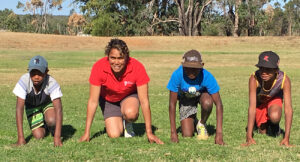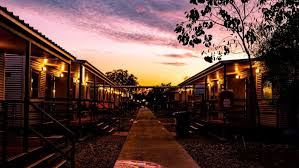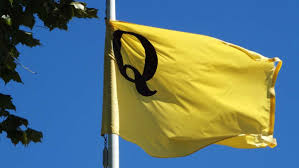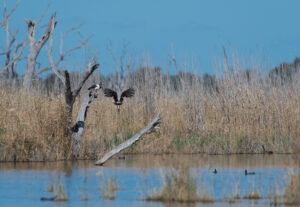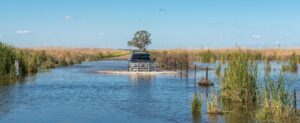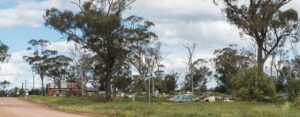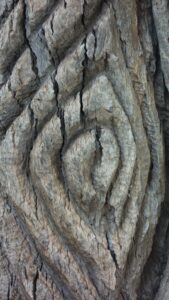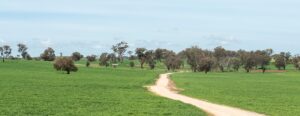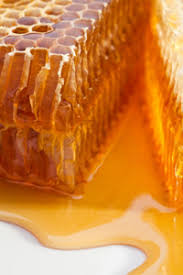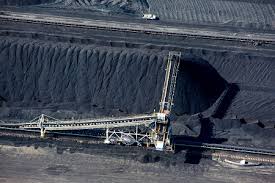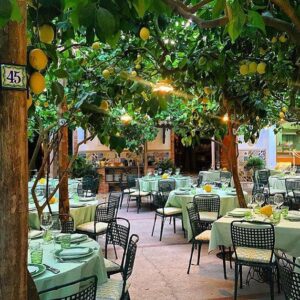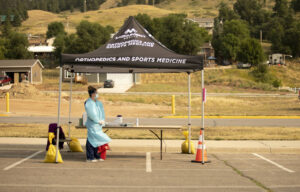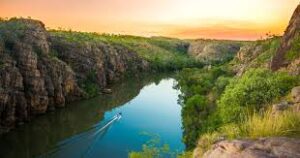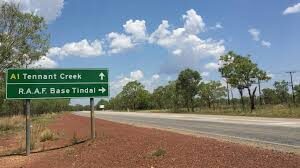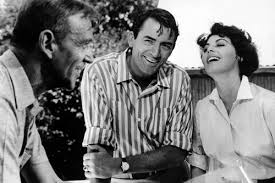I was given the latest biography of Governor Macquarie last year for my birthday. Of the cast of so-called British invaders, Arthur Philip and Lachlan Macquarie have stood out for their positive effect on the early colonial settlement.
Both men stood above the graft and corruption of a community of rogues that sat round the rum barrel and who had already destroyed one Governor in Bligh.
I named the Oration that the Australasian Faculty of Public Health Medicine (AFPHM) holds annually after William Redfern, who Macquarie recognised for his skills in health, although he had arrived in Sydney as a convict. Again, Macquarie promoted Francis Greenway, the convict architect – one of his early assignments was to supervise the renovation of the dilapidated Sydney Hospital.
Governor Macquarie, especially in his early years, was both energetic and innovative. Unsurprisingly the then Sydney establishment, having destroyed his predecessor, progressively undermined him using tactics that have persisted until the present day.
Remember, the Tall Poppy syndrome had its genesis in the early NSW colony.
Macquarie was not particularly well in 1820 near the end of his Governorship when he entertained the Russian mariners, who turned up in Sydney for repairs and replenishment after sailing in the Antarctic.
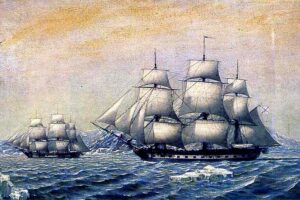
The two Russian ships, the Vostok and Mirinyi were under the command of Captain Thaddeus von Bellinghausen, one the greatest Russian explorers. He had served in both the Russian and British Navy, which suggests that he was at least competent in English. He had circumnavigated the world between 1803 and 1806. When he berthed his ships in Sydney in mid-1820 he and his crew were then partially through circumnavigation of the Antarctic continent. His expedition has been described as “one of the greatest Antarctic expeditions on record, well worthy of being placed beside that of Cook.”
There is no record of the consumption of vodka, rum and Scotch but Macquarie’s hospitality was not mirrored when a Russian ship, Amerika visited in both 1832 and 1835. The press reports reflected the fear of a Russian invasion, which was heightened later during the Crimean War.
And in the latter part of the century when the Russians visited again in 1882, the Melbourne Age editor, David Syme, was duped into believing that Britain and Russia were about to go to war when there were three Russian warships in Port Philip Bay, and their commander Admiral Aslangegoff was ensconced in the Menzies Hotel.
It is reported that the Admiral rebuffed all invitations, even though in Melbourne there was an honorary Russian consul, James Damyon who, judging by his mansion in Glenferrie, probably could have accommodated the Admiral. Melbourne, then extremely wealthy, certainly had its moments. The suggestion of an imminent war was refuted from London and the whole episode was found to be a hoax.
Australia escaped what occurred in Africa, where the European nations subdivided the Continent during the nineteenth century – at great cost to the indigenous people. This had been happening earlier with Portuguese, Spanish, Dutch and British colonial invasions, but in the nineteenth century they were joined by French, German, Belgian and finally Italian interests. Even the Danish had briefly ventured into Africa and hence there was a land grab of massive proportions with subjugation and dispossession of the indigenous people.
Our continent remained a British settlement even though there were many European nations plus the Americans and later the Japanese roaming around the Pacific looking for plots of land on which to plant a flag.
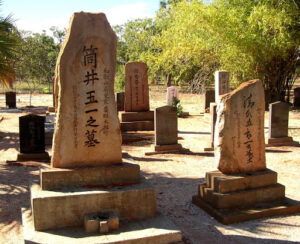
Yet around Broome, there are Aboriginal people with Japanese names; in Darwin Chinese names, but most Aboriginal people have a white fella name indicating some European ancestry. I have West Coast Irish ancestry, but my name is that of the British invaders into Ireland. I suppose we could go about rejecting these names, and I don’t know whether any of the Premier of Queensland’s ancestors were on any of the Russian ships. At some time, we are all invaders with different reasons – it is what makes up that mess which is Us.
The point is that Australia escaped being hacked about by European countries. It is not inconceivable that the Dutch could have colonised the West; the French Tasmania, and, given the evidence of the stranded Mahogany ship, the Portuguese in Western Victoria.
Therefore, Australia was left to the British, and those crucial years in the late 18th century were lost to other potential colonisers. That homogeneous colonisation assisted us becoming a nation.
Yet in 2020 this minuscular coronavirus has enabled those populist chancers who control some of their States, who seem to view their fellow Australians from other States as contagion, full rein to destroy the integrity of the country.
I have lived in the majority of States. I accept what Daniel Andrews has done with Victoria; I understand why the NSW Premier has acted as she has done with the NSW Border with Victoria – both Andrews and Berejiklian are reasonable people – however reasonable is not perfection. But the others – what a bunch of chancers, so far out their depth that they think that they are walking on water when they are in fact drowning.
The most depressing sight is that of Morrison changing the pillowslips when the whole structure of Australia is quaking from the foundations upward and threatening to disintegrate.
A Hundred Kilometres South of Louth
This happened when we were driving a clapped-out rental car back from Adelaide to Sydney and somehow we had strayed onto the road along the Darling River from Wilcannia to Bourke. It was a beautiful day, and we decided to go a different way home.
There are a couple of watering spots on the way to Bourke. Tilpa (population three) with a war memorial to Breaker Morant is one. The pub at Tilpa is a corrugated iron shed with a veranda. When we arrived that day, it was rocking and rolling with pig shooters. The noise could be heard from across the road, where we parked the car.
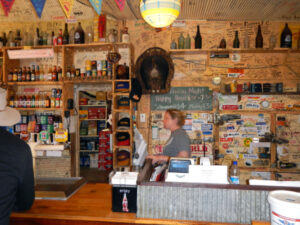
We were thirsty – so I walked into the bar. As soon as I put my foot on the bar floor, all eyes turned towards me and everybody stopped talking. Eyes and silence followed me to the bar. I resisted asking for two chardonnays, and asked for two schooners of light beer.
“Cans do?” the barman broke the silence.
“Yep.”
I put a ten dollar note on the bar, and said “Keep the change.’
“Not enough.”
I added another ten dollar note, picked up the cans, and weaved my way out of the bar. The ripple of disdain was noticeable from some of those who looked me up and down. There was barely any movement to make a path for me. Once I was out of the bar, the noise resumed. I had given them a butt for their collective feeling of superiority. Cans of light. “Girlie” beer! What would you expect from a joker like that!
This silence is also found in Ireland. Walk into a bar in a rural pub there, and you learn the sound of silence. Make sure that there are enough distracted locals in the bar- otherwise you may find yourself in a conversation.
Xenophobia can only go so far, but as you’ll find out it does need a throng to flourish.
However, there was a rock at Tilpa, which seemed to mark the junction of two tracks. It was a bit heavy, but we wrestled it into the car boot. It now lies in the front garden at home, a reminder of Tilpa, a large sandstone not alone but surrounded in the garden by rocks from around the world. These rocks remind us of where we have travelled. Tilpa, the rock, seems happy here. No xenophobia between the rocks and not forgetting the neighbourly Russian sage growing in the crevices.
Spotlight on the Gig Economy
The gig economy gets its name from each piece of work being akin to an individual ‘gig’ – well so they say.
I remember a gig as a little seat between two very large wheels being drawn by Dobbin. The gig is also has been quoted as a deprecatory term for a “flighty girl” and subsequently indicated anything, which whirls, or is dangerous or unpredictable. The horse-drawn gig always suggests instability, but one got a good view.
Therefore, when I was whirling around in part-time work to keep myself financially alive, I participated in what was the gig economy without it being named as such. As I mentioned once before, I rode the back of a security van with a loaded pistol in my pocket and no idea how to use it. Up front were a couple of firemen earning a few quid on their days off. They were the blokes who actually carried the payroll. For my part, squashed among the payroll tins, I never worked out whether my employment was recorded – probably not but I did use my real name.
However, that was not my most interesting gig. I was asked whether I would like to run one of the spotlights at the Water Follies, an American outfit, which came to Australia in the summer over a number of years. They performed on the Kooyong Tennis Centre Court.
First, I had to learn to operate the spotlights. The spotlight was formed by the carbon cathode and anode sparking and burning at some extraordinary temperature inside a metal box into which a window was inserted so you see the two carbon electrodes. This was important because the worst thing possible was for the anode to burn out before intermission. So there was an optimal distance between the two carbon electrodes, a knack that had to be learned, as was making sure that the spotlight was a circle. Also, I could not compromise the integrity of the circle of light by allowing the electrode shadows to intrude into it. That was also a knack, and if that was not mastered then I would not be given more work.
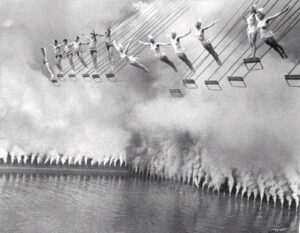
The spotlight had various coloured filters and a shutter to block out the light. This was used when the spotlights had to be doused when the Water Follies’ divers were doing their routines and when they mucked up, the spotlight workers were blamed by the announcer for dazzling the divers. For the first time I learnt that truth can be alternative reality. Our spotlights were always shuttered during the diving segment.
Everything was manual, and during the intermission I had to replace the anode and given the heat being generated I needed gloves and a tool to remove and replace the anode. My employer did not provide any. Thus, I used heavy gardening gloves and long nosed pliers from the family toolbox.
The other thing I learnt on my first night was how far I had to trudge up the stands and how far the drop was behind my seat next to the spotlight. In those days, thank God, heights did not worry me.
How did I learn the trade? On the job. I worked around the spotlights in the Princess Theatre and I estimate that, as a side benefit, if you call it that, I saw “Kismet” 32 times. Yet I never tired of hearing Hayes Gordon singing “A fool sat beneath an Olive Tree…” Later I could have added or “perched above the Centre Court at Kooyong when the wind was blowing and I had forgotten my sweater”.
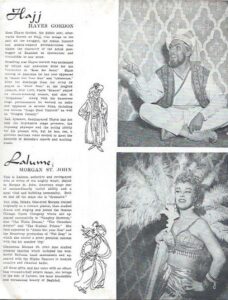 Hayes Gordon, the “Kismet” lead, was of that genre of baritones who always appear larger than life. Even though he had been proscribed and hence virtually exiled from his home USA by McCarthy and the House Unamerican Activities Committee (HUAC) he never lost his genial front and the twinkle in his eye – great memories of him. He would have been 100 this year.
Hayes Gordon, the “Kismet” lead, was of that genre of baritones who always appear larger than life. Even though he had been proscribed and hence virtually exiled from his home USA by McCarthy and the House Unamerican Activities Committee (HUAC) he never lost his genial front and the twinkle in his eye – great memories of him. He would have been 100 this year.
There was definitely one benefit of the job. The Kooyong railway station near the Courts was on my train line – eight stations from home. That was very useful because in those days very few of us had cars.
If it has e- before the technology, it must be e-good?
Sooner or later, the trials of e-scooters will end and a decision will be made. Not all hyped technologies succeed: the much-vaunted Segway is ceasing production.
The same fate probably awaits some of the many electric personal transport devices on sale.
In the meantime, it may well be battles over policy that matter most. Pavements, cycle lanes and roads are ‘all up for grabs’ as streets are reshaped in the post-lockdown world.
Whether e-scooters and other small electric vehicles are allowed to share this planned cycling infrastructure could be pivotal. Scooter companies want it. Others aren’t so sure.
When I read this, I was incredulous. Weren’t these vehicles toys? But then I do remember when Segways were being spruiked from 2002 onwards as an answer to negotiating the traffic. Now production ceasing, the company has switched to making electric scooters.
What I find interesting about the rise in electric car manufacture is a concomitant rise in concern for the waste produced by this technology and how to remove it safely without further polluting the environment.

After all, previous transport technology never factored in the pollution and waste. Even with the horse, the streets were covered in excrement. In addition to its look and smell, it was one the major sources for tetanus bacteria. The best example of what it must have been like is around Central Park in New York where the horse-drawn carriages congregate.
The other technologies – whether it be the steam engine of the locomotive or the internal combustion engines of cars and trucks or the jet engines scarring the troposphere where most of the carbon dioxide is lodged – have waste products that have belatedly not only been recognised but also been the subject of investigation into its removal.
For instance, it took 80 years before lead was removed from petrol in Australia, even though the toxicity of lead was well-known.
I do not pretend to know much about the technology that is driving the cost and efficiency improvements in electric car manufacture. However, it seems clear that electric cars are set to replace the older technologies. The time scale will be driven by concerns over climate change and the need to travel – and the economics
Somewhat encouraging is that unlike previous technologies, concern is being shown over what you do with the pollution and waste left until well after the actual technology was developed.
The metallurgical aspects of battery technology are driven by the availability of the vital metals. In this case all roads lead to China, with its near monopoly on rare-earth production.
The commonly-mentioned elements are cobalt, lithium and nickel. Most of the cobalt comes from the laughingly described Democratic Republic of Congo under hideous artisanal conditions employing child labour. Costs of extraction are low but pollution high. Most of the big cobalt mines are owned by the Chinese and the biggest refiner of cobalt is China. The car manufacturers realise this and with an eye to the consumer, other more ethical sources of cobalt are being investigated. For instance, BMW has been negotiating with Australian producers. While Australia’s supplies of cobalt are dwarfed by the Congo’s reserves, they are nevertheless substantial.
Lithium is mentioned as an essential metal in electric vehicle batteries but the use and improvement in the use of lithium is dependent on consistent supplies of cobalt. Other metals, palladium and nickel, are mentioned in the production of these batteries, but always there is the mention of the rare earths – 17 elements which are classified as lanthanides. Here China clearly dominates, and which of the rare earths is preferred in electric car batteries is kept as secret as KFC’s “secret recipe of eleven herbs and spices”.
Coal and petroleum were single substances – easily identified and subject to sub-classification. Uncomplicated; even our future Prime Minister was able to identify coal for all his Parliamentary colleagues. However, he might struggle to distinguish an ingot of samarium from one of terbium, if these are relevant. He could be excused because the battery producers do not publicly identify any particular rare earth.
The production of the electric car battery which will enable the electric car to travel from Sydney to Perth, averaging a little below the speed limit and yet not weighing the equivalent of a Leopard tank, with perhaps only a need to charge the battery every 1,000 kilometres (the newest batteries guarantee 800 kilometres), is very tempting – even for Mr Musk. The distribution of charging stations is vital, and their placement will require much tactical thought.
Since the nature of the battery and the interdependence between metals means that the cost and pollutant side-effects need to be factored in, the question of what to do with waste, not only of the metal ore production but also of waste disposal, looms large. It is being suggested that, given the scarcity of some of these metals, there will be a strong incentive for recycling – pyrometallurgy being one such means, good for cobalt but not for lithium. There is no one technology that suits all.
However, what is heartening is the level of debate about minimising pollution and finding the best way to deal with waste, starting now when the electric-powered car is emerging from its infancy.
It will be interesting to see how Australia’s policy makers cope, given the rash of sustainability policies being announced, none of which encompass electric vehicles, and given the activity around this area, I would have thought should be a worthy investment.
My friend is not so sure. He constantly is assailed by a trail of spruiking, detailing how quickly the electric battery grail is advancing. To him, it reinforces his belief that the technology is far from settled. I would have thought that it is an incentive for Australian investment. I cannot understand why Australia wants to invest in areas that have been shown to have no future – like carbon capture – or have a limited future like gas; and yet ignore the electric battery, which does have a future. Yet the technology is far from settled. Getting it right would presumably provide a return on the investment. Just give it a timeline.
Death of an Orchid
We had a bumper year growing orchids this year. As the orchids wilt and die, one was left on my desk. The three sepals have already shriveled into umber, the veins once green have changed to brown lines. One leaf remains defiantly that soft green still with veins of green, but death is coming as the very tip of the leaf has that telltale umber shade.
The central column remains strong and the colour of the labellum still has its flamboyant attractiveness, which invited many suitors to pollinate. It still has that glorious magenta lip with the colour dissolving into a flecked trail for the suitor to follow into its interior. The anther cap is dying faster, but then it has always been an accessory. Her companion orchid on the stem stills survives in the vase with its bodyguard of lavender spears, young and attractive but soon themselves to die, keeling over, not retaining the regal exit of the orchid flower.
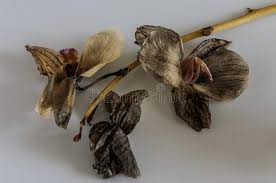
The orchid flower will be allowed to die gradually on a comfortable place on my desk – not trampled on a garden path or left to rot in a garden pot. Dear orchid, I shall watch over you – your nobility in dying will be respected, that I guarantee.
Mouse Whisper
I was combing my whiskers when I detected him talking, perhaps to me. He had just pushed himself away from the screen. He was not happy. However I worry myself when in this world so many of my brothers and sisters exist in camps labelled “medical research”.
I thought this is one thing the Virus would have killed, if the “Me too” movement had not got in first. But, no. The next James Bond movie is due for release in November. It still stars Daniel Craig. “No time to Die” is the title. I would have thought it is the time for these films to die. The idea of having James Bond converted to a colored woman heroine is both illogical and laughable. It was bad enough to see the Queen of England complicit. Judi Dench should be ashamed of her appearances and in so doing condoning the primal underpinnings of those films in which she appeared.
James Bond, the figment of a decaying order on the cusp of irrelevance, even when the first Bond film was released, with its campy Sean Connery and its good ol’ sexist escapism and overlay of technological gimmickry. Over the decades the films have gradually transformed into a series of sado-masochism panegyrics.
Torture in our democratic society is not escapism. Yet the Bond films seem to wallow in it and in so doing assist in deadening society to the atrocities being committed all over the world, often in the name of democracy. The problem is that the torturers seem never to be bought to justice. They just fade away into the background knowing there will be no retribution.
We thus are helpless enough without filmed torture being exploited to pay for somebody’s yacht on the Mediterranean.


